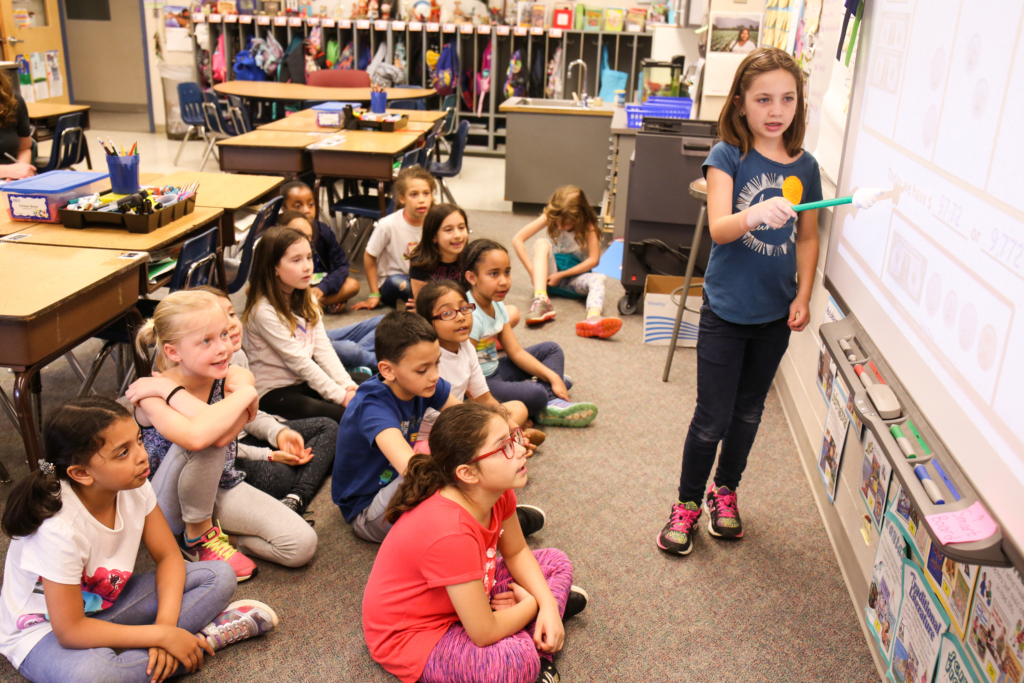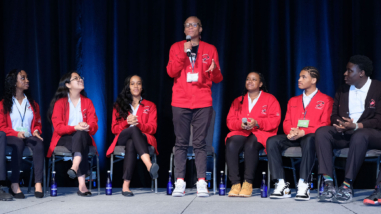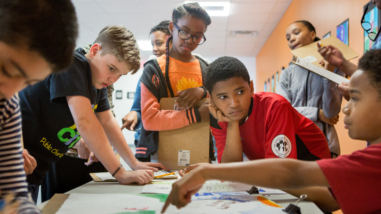For teachers, deeper learning is about letting go
Teachers can achieve deeper learning in many ways, and deeper learning classrooms all look different. But a common thread is that educators empower students to be more independent and take a more active role in their learning process. Burgin used to teach from the front of the room in a traditional way, where the class often worked as a whole group and she was the prime source of information. She worried if she moved toward a student-led approach, she wouldn’t get in all of her instruction and bad behavior might ensue. In particular, she feared a less directed class might become a less focused class, and that might mean lessons weren’t hit and children might goof off.
Burgin is hardly the only teacher to have had those fears. Across the board, teachers attending the 2017 Deeper Learning Conference at High Tech High in San Diego cited “letting go,” or “stepping back” as key challenges to deeper learning instruction. This way of teaching is aimed at helping students master content, think critically, work collaboratively, communicate effectively, learn how to learn, and develop academic mindsets.
Schools are shifting to this approach to learning because college leaders and employers say students are graduating from high school without some of these critical skills. In a recent Pew Research Center survey, experts predicted emotional intelligence, curiosity, creativity, adaptability, resilience and critical thinking would be the most-valued skills among job seekers in the coming years.
Teresa Stone, a first-grade teacher from Cincinnati shifted her teaching practices this year, after 23 years in the classroom. Her school, Winton Woods Elementary, tapped New Tech Network to help educators move toward student-led, project-based learning, which can support deeper learning.
“It’s hard when you’re used to being the captain of the boat, and you’re then put in a position where the kids will say, ‘Wait a minute. Let’s go that way.’ You have to be able to say, okay let’s see where that takes us,” Stone said.
Making way for students to take the lead
Traditional teacher-led instruction is typically what most teachers experienced in their own childhoods, so envisioning something new can be hard. Executing it can be even harder. While Stone said she had always done projects with her class in the past, she now realizes those were just teacher-led activities rather than authentic deeper learning experiences for students. “My concept was if they were doing something hands on, then that was a project,” Stone said. “But now I understand if I’m giving them supplies, if I’m telling them what to do, if I’m telling them how to make it, that’s not deeper learning.”
She said her students are currently studying the planets and decided to make paper-mache models. Together, they interviewed the art teacher, determined how big a balloon they needed for each model, and researched where they should be in relation to the sun and each other. “Those are conversations I would have never expected from first graders before,” she said. “Their ability to work together and build each other up has been truly amazing, and I won’t ever go back.”

Esther Robles, who teaches 2nd grade in El Centro, Calif., said her school, Ballington Academy for the Arts and Sciences, went to a student-led learning model last year. Instead of giving her students the essential question that drives each class project, she now asks students to come up with that question. Robles also used to create rules for her class and post them on the wall. More recently, she shifted to working together with the kids to create a shared set of expectations. She said the children follow these much more closely.
“That’s a perfect of example of how you can have an orderly, focused, and courteous classroom where the kids own and understand the norms, because they built those norms with you,” said Ron Berger, Chief Academic Officer at EL Education, a national school support network. “Once teachers have built up their own confidence enough to go this route and experience it, they never want to go back to an autocratic classroom where children only behave when you’re watching them.”
Laché Williams can attest to that. She teaches a fourth-grade class of all boys at L.W. Conder Elementary School in Columbia, S.C. She uses blended and project-based learning. But Williams said she didn’t start out this way. “When I started teaching I was so focused on classroom management. I think I did whole-group, direct instruction the entire year during my first year. I was so afraid of small groups. I was afraid of losing control of the class.” Williams said, “Today, I’ve learned to let go but still maintain the structure I need along the way.”
For example, Williams gives her students pacing guidance to make sure projects don’t take too long and checks in with them to see where support might be needed. She models good conversation and collaboration skills and has the boys play games that build teamwork.
Justin Holbrook, who teaches fourth-grade at Roland Park Elementary/Middle School in Baltimore, leads a highly student-led classroom. He typically meets with rotating groups of students twice a month to gather feedback on how things are going in class and get ideas for improvements. And he empowers students to take turns leading their peers in a math lesson each week. He acknowledges that many teachers fear handing over control of learning to students in this manner. However he says strong professional development that can help teachers be more student centered.
More guidance for teachers
“Professional development should be led by teachers, and the voice of teachers should lead things. If we want kids to dictate their own learning, we need to dictate our own learning as well,” said Holbrook, who meets with his students twice a month to discuss what could be improved in class and empowers them to research and lead a math lesson once a week.
Linda Darling-Hammond, President and CEO, of the Learning Policy Institute, agrees professional development needs improving. “I think it is often the case that a lot of professional development is not structured to be deeper learning for teachers. They’re often pulled together in an auditorium or teachers’ lounge to be lectured at,” she said.
Darling-Hammond noted some strong professional development opportunities are emerging, like the High Tech High Deeper Learning conference, in which teachers direct their learning, collaborate, and work on projects. But she said that’s not reflective of the majority of professional development teachers receive. Teachers need good professional development that helps them learn not just how to take a step back but also how to create structures that enable students to engage in deeper learning, Darling-Hammond said.
She says teachers need to gain the skills needed to encourage and support strong, independent learning in their classrooms. For example, they need to know when to provide students with feedback, how to empower them to choose projects wisely, and which strategies to use to guide students toward working productively in groups.
In Burgin’s Arlington, Va. School, professional learning is teacher-centered. Teachers are observed and get feedback on areas that need improving. They then chart a course of action. “They have me, coaches, their peers, all available to them, but they set a plan and select how they’re going to improve,” Principal Lynne Wright said.
Or as Burgin put it, “Our professional development isn’t about ‘read that book that’s flying off the teacher book shelves,’ or ‘do this fad that everyone is talking about.’” Rather, she said, “It’s what I feel embodies deeper learning.”
Inside Burgin’s classroom, the benefits of that approach appear evident. Burgin smiles while talking to visitors as her eyes wander across the room and zero in on a desk belonging to a girl named Eva. “Problem solving!” she exclaimed pointing to a plastic pencil sharpener wedged under a leg of the girl’s desk. “That sharpener is broken and not useful for sharpening pencils anymore, and her desk has been wobbly. Look at that! She solved the problem on her own,” the teacher said beaming.
Editor’s note: Nancy Zuckerbrod is a freelance writer and consultant to nonprofit organizations. Previously, she spent more than a decade as a journalist for The Associated Press, including as the national education writer in Washington and as a correspondent in London.




